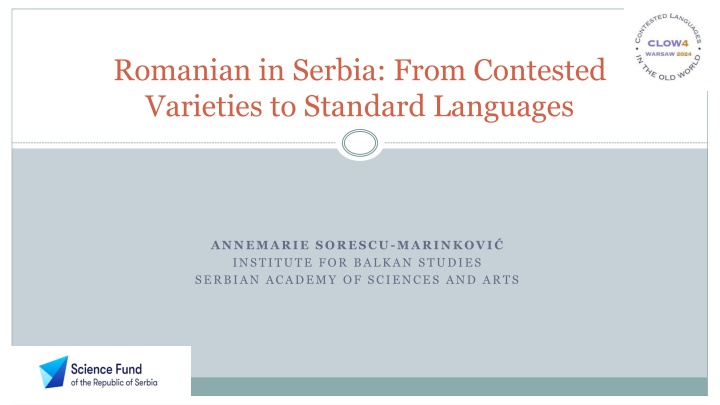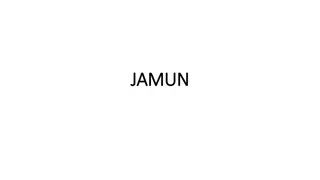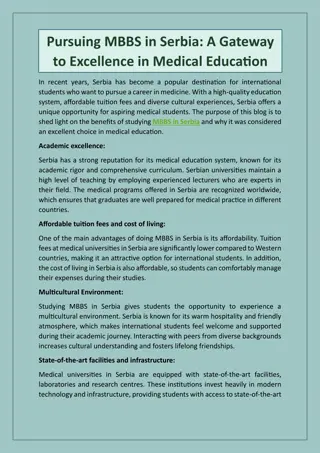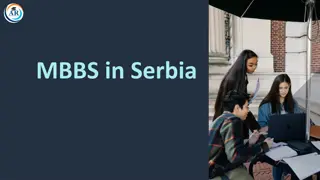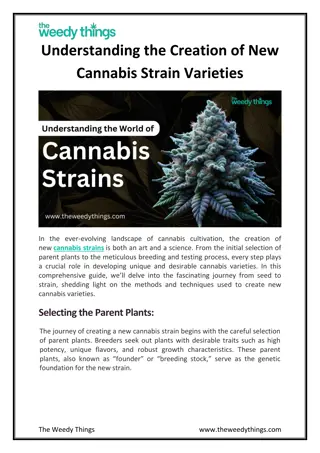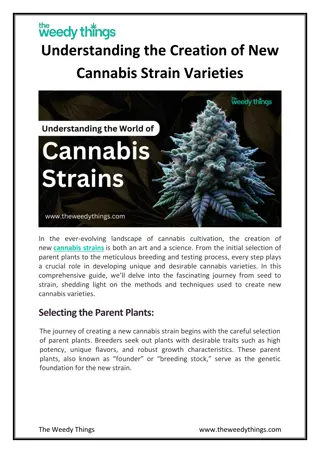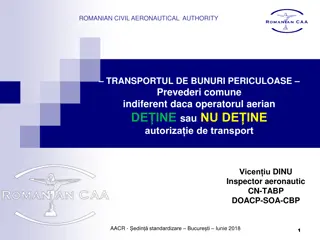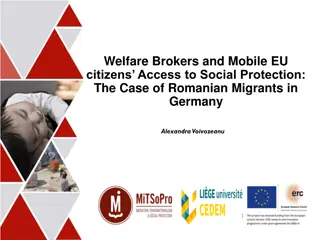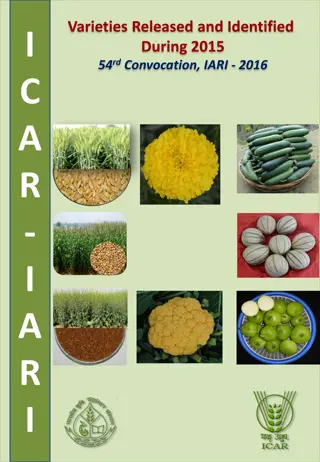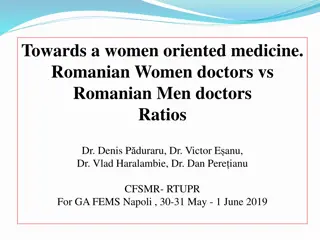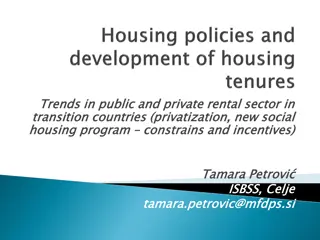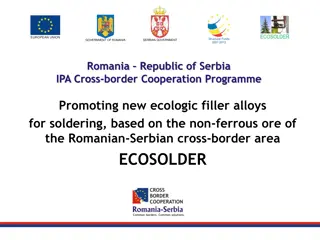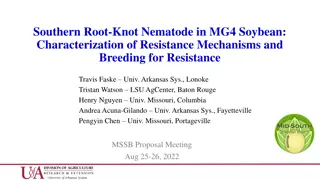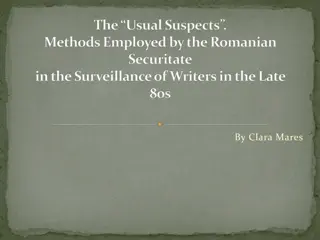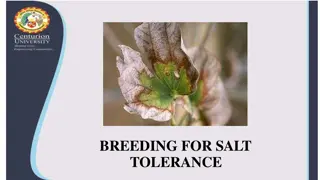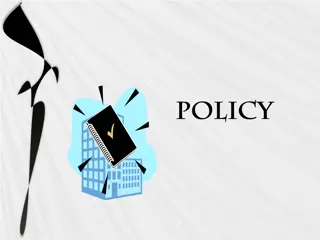Romanian Varieties in Serbia: Status, Policy, and Planning
The content discusses the linguistic landscape in Serbia, focusing on Romanian varieties - Vojvodina Romanian, Vlach, and Bayash Romanian. It delves into the language status, policy, and planning for these varieties, exploring their historical background, community treatment, and language sustainability. The presence of different Romanian-speaking communities in Serbia is examined, highlighting the unique characteristics and challenges faced by each variety. Additionally, the contentious issue of standardization and stigmatization towards these communities and their languages is explored in-depth, shedding light on the complexities of language diversity and identity in the region.
Download Presentation

Please find below an Image/Link to download the presentation.
The content on the website is provided AS IS for your information and personal use only. It may not be sold, licensed, or shared on other websites without obtaining consent from the author.If you encounter any issues during the download, it is possible that the publisher has removed the file from their server.
You are allowed to download the files provided on this website for personal or commercial use, subject to the condition that they are used lawfully. All files are the property of their respective owners.
The content on the website is provided AS IS for your information and personal use only. It may not be sold, licensed, or shared on other websites without obtaining consent from the author.
E N D
Presentation Transcript
Romanian in Serbia: From Contested Varieties to Standard Languages ANNEMARIE SORESCU-MARINKOVI INSTITUTE FOR BALKAN STUDIES SERBIAN ACADEMY OF SCIENCES AND ARTS
Outline Language status, policy and planning of three Romanian varieties spoken in Serbia Vojvodina Romanian, Vlach and Bayash Romanian. Vojvodina: Romanian is an official, minority language Eastern Serbia: the Romanian variety is standardized as a separate language Bayash Romanian: thrives only as a spoken language What stigmatizing a community and contesting its language does in the long run to its speakers
Romanian varieties in Serbia Vojvodina and Eastern Serbia: a contiguous region The presence in Serbia of two different communities speaking two varieties of Romanian is the result of different historical events difference in their treatment by the Serbian outgroup Bayash scattered all over the country
Romanian in Vojvodina Part of the Austro-Hungarian Empire. Romanians: regular colonizations and migrations within the empire. After WWI - Kingdom of Serbs, Croats and Slovenes. The first Census in Yugoslavia to include Vojvodina (1948): 63,130 Romanians. 2022 Census: 23.044 Romanians. Members of the community are bilingual. Official languages of the Autonomous Province Vojvodina: Croatian, Hungarian, Romanian, Rusyn, Serbian and Slovak. Romanian is used in the legislative and executive bodies, in church and media. Education in Romanian: primary, secondary and partially tertiary level. Standard Romanian local Romanian variety.
Vlach in Eastern Serbia Part of Serbia since it was granted autonomy within the Ottoman Empire in 1830. Spontaneous migrations in search of a better life, in the 18thand 19thcenturies. A previous layer of Romanized population? Census data: huge differences. The members of the community display multiple, contextual, simultaneous identities. They identify themselves as Romanians or Vlachs, and are always identified as Vlachs by the outgroup. Researchers claim Vlach has a low prestige both within the out-group and in-group. Vla ki rum nje e Year Vlach mother tongue Vlach ethnicity 1953 198,861 28,047 1971 139,902 14,724 1981 129,613 25,596 1991 71,534 17,804 2002 54,818 40,054 2011 43,095 35,330 2022 23,216 21,013
Vlach in Eastern Serbia Vlach: restricted to the family domain. Intense assimilation since 1950s. Bilingualism 2012: spelling system 2013: optional subject Vlach speech with elements of national culture Used in the media and on the Internet. Language planning measures taken by the engaged members of the community. 2015: standardization of the Vlach language - fiercely contested by Romanian linguists and by members of the community. Vlach grammar, dictionaries, school books, translations and an incipient literature. 2023: a second standardization
Bayash Romanian Scattered all over Serbia Different names: Bayash, Rudari, Romanian Gypsies, Karavlasi Mother tongue: Romanian varieties with different dialectological bases; considered Roma by the majority population 18thand 19thcentury, after the abolition of slavery in Romania Our language Our People Bayash diaspora Their language has no status in Serbia, unlike Croatia or Hungary Contested language contested identity
Contesting languages Researchers claim that Vlach has a low prestige. Project Vulnerable Languages and Linguistic Varieties in Serbia (www.vlings.rs) Vlach: one of the eight linguistic varieties we focus on (Aromanian, Banat Bulgarian, Bayash Romanian, Ladino, Megleno-Romanian, Romani, Vojvodina Rusyn) 160 interviewees from the Vlach community. Sociolinguistic questionnaire - 150 questions Language attitudes section: 1) Has anybody ever forbidden you to speak your language? 9% yes 2) How do you feel when you speak your language in the presence of Serbs? 23% negative feelings 3) Do you think your language is important? 88% yes 4) Do you think your language should be transmitted to younger generations? 86% yes
Contesting languages 1) What do you think is the most important thing which would help revitalize your language? Not to introduce it in schools. The reduced prestige of the language within the community might be the result of the long assimilation process, contempt and stigmatization from the majority population, and contesting and forbidding them to speak their language.
